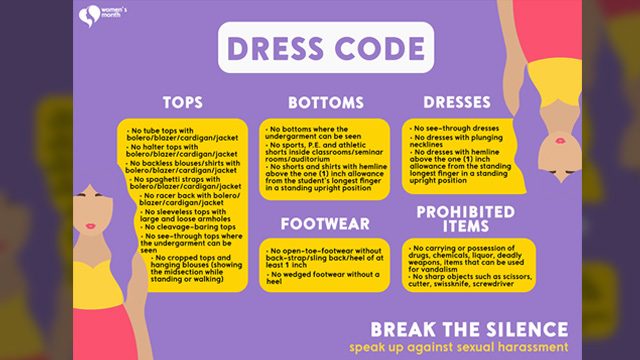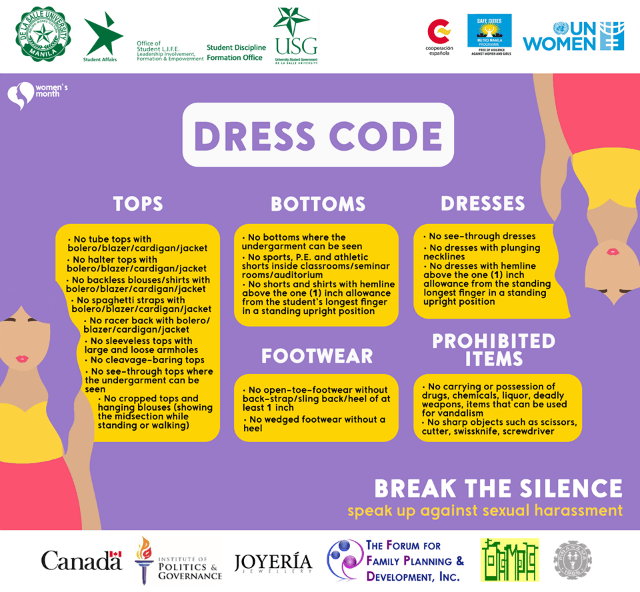SUMMARY
This is AI generated summarization, which may have errors. For context, always refer to the full article.

MANILA, Philippines – “Our guests may enter the campus according to their individual taste; however due to university rules and regulations, they are urged to wear attires that would consider the educational character of the university.”
This was the statement released by the the De La Salle University (DLSU) University Student Government (USG) on Thursday, March 22, 2018 in response to their controversial “dress code” posted a few days prior.
Earlier, DLSU USG posted on Facebook the dress code for their event titled “Break the Silence: Towards a Safe and Violence-Free Public Spaces for Women and Girls.” Netizens slammed the post, claiming that, ironically, the restrictive dress code promoted rape culture and victim-blaming.
Netizens also argued that there were numerous and specific types of clothing that the infographic stated should not be worn during the event.
The event is in partnership with the UN Women’s Safe Cities Metro Manila Programme, along with countries such as Spain and Canada. Spain is already implementing the UN Safe Cities and Safe Spaces program alongside the Philippines, while the Canadian ambassador will be a speaker during the event.
The original post of the “dress code” has since been taken down, upon the request of their partner organizations, according to DLSU USG. It was shared more than 4,000 times on Facebook before being removed.

“We are proud to host the event, DLSU is one of the leading universities that promote safe spaces for women and girls campaign in the campus. We have zero tolerance for sexual harassment within and outside the campus,” Gabrielle Perez, Vice President for External Affairs of the DLSU University Student Government said in the statement.
The USG’s statement has been shared more than 300 times at the time of writing, and has received different reactions from netizens.
There were some who defended the USG and blamed people for jumping to conclusions
Meanwhile there were others who viewed the apology as inadequate, and the USG not understanding what they did wrong, while outlining the undertone sent by the original post.
The issue of dress codes within schools and universities is not new in the fight for women empowerment and equality.
In 2013, an opinion article tackled the issue of dress codes which perpetuated the “victim-blaming” line. The article said it was time to change the “antiquated systemic misogyny that is the dress code.”
While the writer conceded that most school rules are meant to be followed for the safety of students, “But what does banning girls from wearing tank tops or mini skirts do? Protect them from the wayward eyes of lecherous strangers? Help them avoid being mauled or molested or, worse, raped? That kind of thinking puts the onus of sexual assault on the victim and perpetuates rape culture.” She wrote to emphasize the flawed logic of such regulations.
Fast forward to 2017, The Huffington Post (which has an entire topic category on “Dress Codes”) published an article talking about the newly updated Evanston Township High School.
The new rules were taken from the Oregon National Organization of Women dress code, which changed their dress code to restrict things such as hate speech and violent imagery, instead of focusing on how much of the body the clothes cover, along with making the restrictions few enough that it applies clearly to both males and females without leaning more towards one or the other, allowing all students to dress in ways they are personally comfortable with, without risk of being shamed for their attire and without causing actual distractions in class with inappropriate attire.
These are examples of the many controversies and stories surrounding the implementation of sexist dress codes in schools. These are shared on social media such as Twitter and Facebook and reach a high number of teens and young adults who likely feel that this issue is very relevant for their generation.
Despite the negative controversy sparked by their original post and subsequent apology the DLSU USG reiterated that it is committed to ending rape culture and sexual harassment. – with reports from Gab Landrito Rappler.com
Gab Landrito is an intern at Rappler for the MovePH and Social Media section. He studied Communication Arts in UP Baguio with a minor in Journalism.
Add a comment
How does this make you feel?
There are no comments yet. Add your comment to start the conversation.